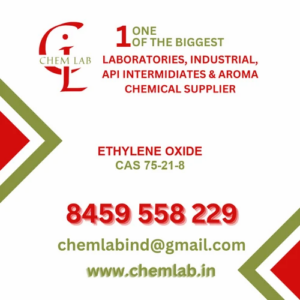Ethylene Oxide: Product Description, Uses, and Technical Data
Product Description
Ethylene oxide (C₂H₄O) is a colorless, flammable gas with a sweet odor. It is a cyclic ether and is highly reactive, making it an important intermediate in the production of various chemicals. Ethylene oxide is primarily used in the synthesis of antifreeze, surfactants, and other industrial chemicals. Due to its reactivity, it is also utilized in the sterilization of medical equipment and in the production of ethylene glycol, which is a key component in antifreeze formulations.
Uses of Ethylene Oxide
- Chemical Intermediate: Ethylene oxide is a precursor for the production of ethylene glycol, which is used in antifreeze and polyester fibers.
- Sterilization Agent: It is widely used for sterilizing medical devices and equipment due to its ability to kill bacteria, viruses, and fungi.
- Production of Surfactants: Ethylene oxide is used in the manufacture of non-ionic surfactants, which are essential in detergents and personal care products.
- Fumigant: It serves as a fumigant for agricultural products, helping to control pests and pathogens.
- Polymer Production: Ethylene oxide is involved in the production of various polymers, including polyethylene glycol and polyurethane.
Technical Data
| Property | Value |
|---|---|
| Chemical Formula | C₂H₄O |
| Molecular Weight | 44.05 g/mol |
| Boiling Point | 10.5 °C (50.9 °F) |
| Melting Point | -111.3 °C (-168.3 °F) |
| Density | 0.881 g/cm³ |
| Flash Point | -17.8 °C (0 °F) |
| Solubility in Water | Miscible |
| Vapor Pressure | 100 mmHg at 20 °C |
| Autoignition Temperature | 425 °C (797 °F) |
| Toxicity | Highly toxic; carcinogenic |
Safety Considerations
- Flammability: Ethylene oxide is highly flammable and can form explosive mixtures with air.
- Health Risks: Exposure can cause irritation to the skin, eyes, and respiratory system. Long-term exposure may lead to serious health issues, including cancer.
- Handling Precautions: It should be handled in well-ventilated areas, and appropriate personal protective equipment (PPE) should be worn.
Conclusion
Ethylene oxide is a versatile chemical with significant industrial applications, particularly in the production of antifreeze, surfactants, and sterilization processes. Its unique properties and reactivity make it a valuable compound, but safety precautions must be strictly adhered to due to its toxic and flammable nature.

